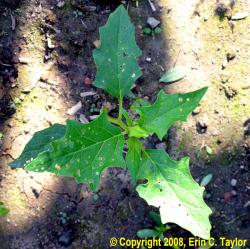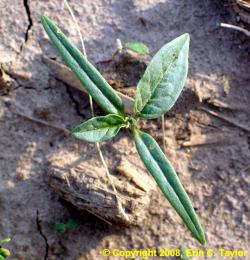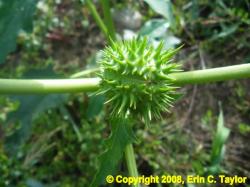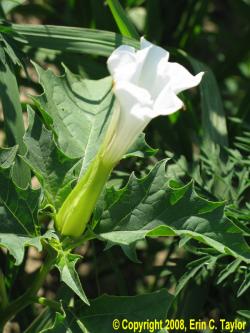Jimsonweed
Jimsonweed (Datura stramonium L.)

Life Cycle:
Summer annual. Jimsonweed emerges in spring (May through mid-June), sets seed in late summer/fall and dies with the first killing frost.
Emergence:
Emerges from soil depths of 3-inches or less.

Seed:
Production Range: Without competition one jimsonweed plant can produce 50 or more seed capsules and 30,000 or more seeds. Each seed capsule generally contains 600 to 700 seeds. Under severe competition one plant may only produce 3 to 4 small seed capsules. Seed capsules are produced until the first hard frost.
Dispersal Mechanisms: Seed capsules and seed are buoyant in water and can remaining floating for 10 days or more. Seeds are dispersed by dehiscence (splitting open of the seed capsule) up to a distance of 3 to 10 feet from the parent plant. Jimsonweed can also be dispersed by farm machinery, water, and impurities in commercial seed.
Longevity: Moderate to highly persistent. Ninety-one percent of seeds germinated after 39 years in a buried seed experiment.
Dormancy: Very little dormancy of mature seeds. Seeds are mature 30 day after fertilization, capsule opens 50 days after pollination and seeds will continue to ripen after fertilization even if the branch where the seed capsule is located is not attached to the plant.


Competitiveness:
One of the more competitive weeds. 4 to13 plants per yard2 can reduce yields of direct-seeded tomatoes by 26 to 71% and soybeans by 15 to 45%. Jimsonweed also interferes with harvesting operations.
Preferred Soil/Field Conditions:
Found on most soil types, but prefers rich soils, including disturbed soils rich in manure (i.e. barnyards).
Management:
Biological
Predation/grazing: Jimsonweed vegetation and seeds are poisonous due to production of tropane alkaloids. Livestock normally avoid eating jimsonweed unless no other vegetation is available.
Decay: Seeds decay more readily on the soil surface.
Mechanical
Tillage: Seedlings are readily killed by tillage. However, older plants may regenerate from lower nodes that are clipped or trampled.
Rotary Hoeing: Hoe before weeds exceed 1/4 inch in height. Once jimsonweed is established it is difficult to control.
Flaming: Effective on small jimsonweed.
Cultural
Crop rotation: Not a weed of small grains or forages.
Planting date: Tillage in the spring triggers jimsonweed to germinate. Because of the extended time of emergence, planting early or planting late to reduce jimsonweed infestations may not be effective.
Chemical
Application timing and effectiveness: Several herbicides are effective in corn, soybean, dry bean, and sugar beets. Control is greater when herbicides are applied to smaller jimsonweed plants. Please refer to E-434, "MSU Weed Control Guide for Field Crops," for herbicide recommendations.
Additional Information:
Jimsonweed can serve as an alternate host of many insect pests and diseases of Solanaceous crops, such as tomatoes and potatoes.



 Print
Print Email
Email